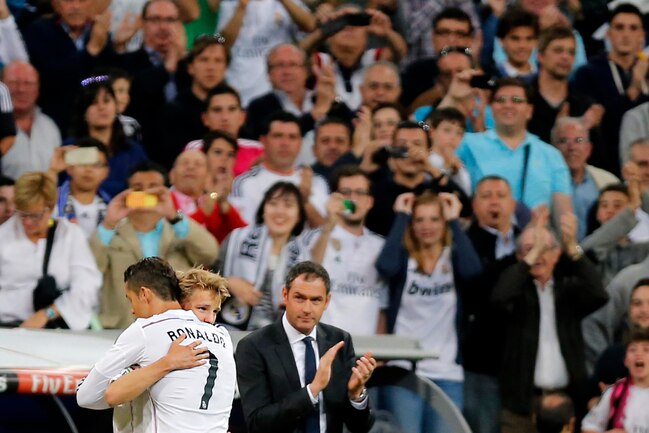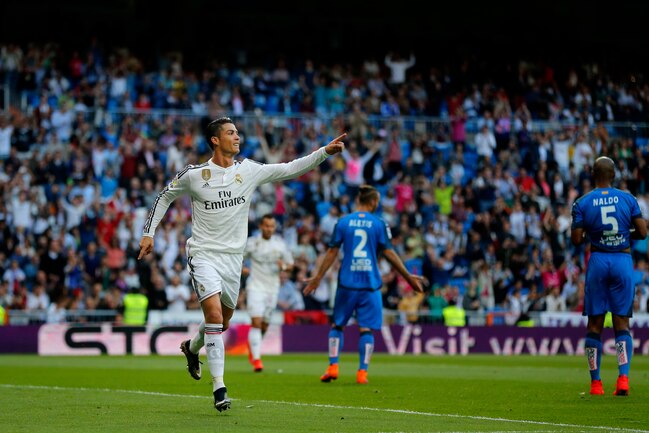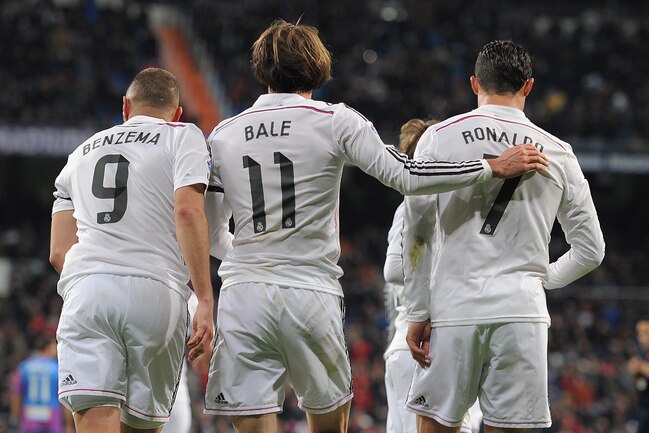Cristiano Ronaldo walked steadily toward the sideline, a 16-year-old standing there waiting to replace him after the fourth official's board had displayed a No. 7. As he approached the touchline, those in the stands of the Santiago Bernabeu rose to their feet, clapping, chanting.
It was a rapturous applause. In the hour prior, Ronaldo's goals had guided Real Madrid through a bizarre period againstGetafe. The hosts had led, 1-0, thanks to the Portuguese's soaring header, but they quickly trailed, 2-1, the ever-lingering self-destructive nature of Real Madrid's defence exaggerated by the lack of sting in the contest.
A peculiar embarrassment this could have been, but Ronaldo's response was both swift and lethal: two goals in three minutes; the first an exquisite free-kick from 25 yards, the second a well-taken penalty after Carlos Vigaray had brought down Javier Hernandez.
Order restored.
Another hat-trick it was, Ronaldo's eighth of the season. His eighth. But it had also been more than that—it had been an emphatic signing off to an extraordinary personal season. Sixty-one goals in total, 48 of them in La Liga. Another Pichichi. Another Golden Shoe. His career tally in white now at 313.
As such, the reception that met Ronaldo upon his exit wasn't your typical one. Fans can get to their feet for almost anyone, but this was different. It was a thank you, the Bernabeu essentially saying: weknow.

Daniel Ochoa de Olza/Associated Press
It was also a rare opportunity for the Real Madrid faithful. Prior to Saturday, it had been 168 days since the Ballon d'Orwinner had been substituted at home, following a hat-trick against Celta Vigo on December 6. The time before that? Last April. Chances to express a special appreciation for Ronaldo at the Bernabeucome only biannually.
Yet as the staggeringly prolific forward left the pitch on Saturday evening, there seemed to be a silent, universal question: Is this guy's historic talent being wasted?
Of Ronaldo's 313 goals for Real Madrid, 225 have come in La Liga. More extraordinary is that they've come in just 200 appearances. And yet, somehow, those galactic numbers have translated to just a single league title.
"Real Madrid have failed Ronaldo," said Graham Hunter, a renowned journalist covering Spanish football, on Sky Sports'Revista de la Liga. Days later, Barcelona legend Johan Cruyff told De Telegraaf, viaGoal: "It's ridiculous that they [Real Madrid] have only won the league once in seven years." In itself, it's troubling. And in relation to Ronaldo, time is running out for Real Madrid to rectify it.
When he switched the northwest of England for the Spanish capital, the Portuguese was 24, a barnstorming winger with outrageous physical gifts. But in 2015, that's not who he is. Now 30, he's older, wiser. Less spectacular, of course, but more efficient. He's evolved.

Daniel Ochoa de Olza/Associated Press
In 2014-15, Ronaldo's evolution has seen him play considerably closer to goal. Charges down the left flank have been replaced with subtle movements within the box; long-distance strikes have become close, one-touch finishes; what were once bullet headers are now acts of a softer precision.
In some quarters, a degree of criticism has met the changes—something that's both utterly ridiculous and painfully short-sighted. Ronaldo is different now, yes, but different isn't worse. In fact, in this case, different might even be more effective. It's so easy to forget how difficult scoring is, let alone doing it 61 times.
Ronaldo is now inescapably a No. 9. The world's finest No. 9, too. But might it be that one of the major factors contributing to an ultimately barren season for Real Madrid has been the club's failure to adapt to that transformation?
In 2013-14, Real's triumphant 4-3-3 system under Carlo Ancelotti was a sight to behold. Of course, centrally, it was underpinned by Xabi Alonso and Angel Di Maria. But nonetheless, it was still a system defined by its front three, one of its keys the "bombing on" of Ronaldo andGareth Bale either side of KarimBenzema.
Ronaldo's evolution this season, however, has drastically affected that dynamic. Closer to goal, away from the wing, Ronaldo no longer "bombs on." He essentially partners Benzema up top, but the system hasn't adapted accordingly. It's remained roughly a 4-3-3—sometimes a hybrid 4-4-2—but one that's become lopsided and slightly dysfunctional.

Denis Doyle/Getty Images
Most of the time, Real Madrid's sheer level of talent has made that redundant. But not in the bigger games. Not against Barcelona, Atletico Madrid, Valencia orJuventus. Evidently, the system needs work; the focal point is still the same guy, but that guy has changed.
As such, Real Madrid are now facing a period in which the team's evolution must match that of Ronaldo. It will be the job of a new manager—Marca reports thatAncelotti's expected departure will soon be confirmed—to craft a system that caters for who the Portuguese is now, rather than for who he once was. The same goes for the club's transfer activity. New faces must be complementary to the new Ronaldo.
Time is of the essence here, too. For LosBlancos still possess one of football's two most devastating weapons: a pillar that an entire club can be built around but are in danger of letting his phenomenal achievements amount to little collectively. Ronaldo has given Real Madrid everything, but it hasn't exactly been a two-way street.
Ronaldo, from the player he was when he arrived, from the player he was just last season, has evolved. To fully harness it, Real Madrid will need to do the same.

Daniel Ochoa de Olza/Associated Press

Daniel Ochoa de Olza/Associated Press

Denis Doyle/Getty Images